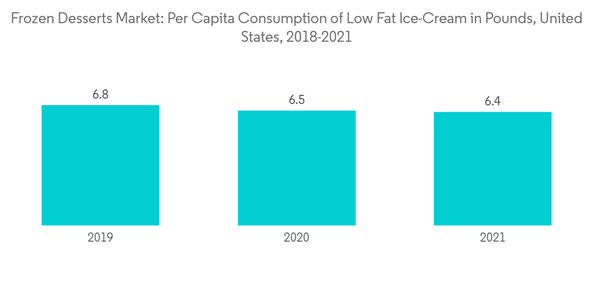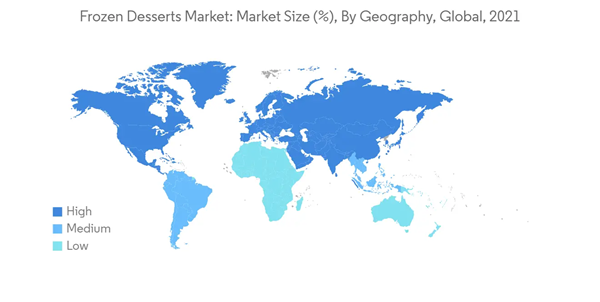The Frozen Desserts Market size is estimated at USD 97.80 billion in 2024, and is expected to reach USD 119.85 billion by 2029, growing at a CAGR of 4.15% during the forecast period (2024-2029).
In recent years, numerous innovative products have been launched in the frozen bakery and desserts category. Consumers are paying more attention to their health and wellness. This has resulted in the emergence of innovative flavors and low-fat, gluten-free products. Increasing demand for low-sugar and low-calorie desserts is expected to drive market growth. Innovation in products, flavors, and packaging has proven to be a crucial growth factor. Ice creams and frozen yogurts are gaining popularity among consumers owing to the convenience of products and time-saving factors. For instance, In June 2022, Noosa Yogurt, a Colorado-based whole milk yogurt brand under the Sovos Brands portfolio, launched Frozen Yogurt Gelato. The products come in four new flavors, i.e., Strawberries & Cream, Chocolate Fudge, Sea Salt Caramel, and Honey Vanilla Bean.
Furthermore, the demand for gluten-free clean-label products is increasing due to their health benefits and different allergies. Gluten-free frozen desserts are widely accepted in the United States, Europe, and other developing countries. For instance, in June 2021, Dawn Foods expanded its gluten-free offerings with a range of frozen gluten-free sweet bakery products featuring injected muffins and chocolate brownies, all made using Dawn's gluten-free mixes and fillings. The new gluten-free frozen range includes a Double Chocolate Filled Muffin made with indulgent Belgian white and dark chocolate chunks. The market is being driven by rising disposable incomes, the introduction of new flavors, increasing impulse purchasing, and huge demand for frozen desserts among consumers globally. Ice creams emerged as the leading product category. The factors affecting the market's growth are flavors, fat content, sweetness, and texture.
Furthermore, India is also one of the fastest-growing frozen industries owing to product innovations. Indian manufacturers are innovating ice creams in different local flavors like gulab jamun, basundi, rose, and many more. Because of these product innovations, the requirement for dessert ice creams is increased in Indian households. Also, the demand for natural ingredients in ice creams is increasing, and market players are fulfilling the demands of consumers. For instance, in March 2022, Vadilal Enterprises, a premium ice cream brand in India, launched a Gourmet Natural Ice cream range that includes five flavors, i.e., Gulab Jamun, Alphonso Mango, Kesar Pista, Classic Malai, and Falooda.
This product will be delivered within 2 business days.
In recent years, numerous innovative products have been launched in the frozen bakery and desserts category. Consumers are paying more attention to their health and wellness. This has resulted in the emergence of innovative flavors and low-fat, gluten-free products. Increasing demand for low-sugar and low-calorie desserts is expected to drive market growth. Innovation in products, flavors, and packaging has proven to be a crucial growth factor. Ice creams and frozen yogurts are gaining popularity among consumers owing to the convenience of products and time-saving factors. For instance, In June 2022, Noosa Yogurt, a Colorado-based whole milk yogurt brand under the Sovos Brands portfolio, launched Frozen Yogurt Gelato. The products come in four new flavors, i.e., Strawberries & Cream, Chocolate Fudge, Sea Salt Caramel, and Honey Vanilla Bean.
Furthermore, the demand for gluten-free clean-label products is increasing due to their health benefits and different allergies. Gluten-free frozen desserts are widely accepted in the United States, Europe, and other developing countries. For instance, in June 2021, Dawn Foods expanded its gluten-free offerings with a range of frozen gluten-free sweet bakery products featuring injected muffins and chocolate brownies, all made using Dawn's gluten-free mixes and fillings. The new gluten-free frozen range includes a Double Chocolate Filled Muffin made with indulgent Belgian white and dark chocolate chunks. The market is being driven by rising disposable incomes, the introduction of new flavors, increasing impulse purchasing, and huge demand for frozen desserts among consumers globally. Ice creams emerged as the leading product category. The factors affecting the market's growth are flavors, fat content, sweetness, and texture.
Frozen Desserts Market Trends
Demand for Low-fat and Non-dairy Products Increasing Consumption
Non-dairy products such as ice creams contain a high content of lipids, vitamins, albumin, carbohydrates, and casein, providing significant health benefits. Shifting trends toward vegan lifestyles owing to increasing health consciousness and socialization trends are propelling the industry and shifting consumers' preferences toward low-fat products. High per capita ice cream consumption has enhanced product demand, particularly in the United States and European countries. Rising incidences of lactose intolerance and other milk-related allergies are fostering product demand. In November 2022, Unilever posted that it plans to launch ice cream from cow-free dairy in 2023. Comprehensive product variations through materials, including coconut, almond, and soy milk, will positively influence the industry's growth. Innovative flavor offerings, mainly including blended flavors, have enhanced product development. Increasing consumer spending on take-home and impulse products will further boost the non-dairy ice cream demand.Asia-Pacific is the Fastest Growing Market
The growing demand for frozen desserts has led to significant growth in the total number of ice creams and frozen dessert retail shops in China. Frozen desserts are bound to achieve great success in the Chinese market, as the increasing demand for low-fat, healthy food encourages people to spend more on these products. A vast population, a prominent young generation, increasing disposable incomes, and changes in dining habits are the major factors that support the frozen desserts market in this region. In China, frozen desserts on sticks go viral due to their convenience. Considering the market demand, in July 2022, Zibo City, in East China's Shandong province, starteinnovativenew innovating ice cream bars in different shapes like cave dwellings, copper coins, and tigers.Furthermore, India is also one of the fastest-growing frozen industries owing to product innovations. Indian manufacturers are innovating ice creams in different local flavors like gulab jamun, basundi, rose, and many more. Because of these product innovations, the requirement for dessert ice creams is increased in Indian households. Also, the demand for natural ingredients in ice creams is increasing, and market players are fulfilling the demands of consumers. For instance, in March 2022, Vadilal Enterprises, a premium ice cream brand in India, launched a Gourmet Natural Ice cream range that includes five flavors, i.e., Gulab Jamun, Alphonso Mango, Kesar Pista, Classic Malai, and Falooda.
Frozen Desserts Industry Overview
The Frozen Desserts Market is highly fragmented and comprises regional and international competitors. The market is dominated by players like Unilever PLC, Nestlé S.A., General Mills, and Yili Industrial Group Limited. The leading players in the frozen snacks market enjoy a dominant presence worldwide. These players focus on leveraging opportunities posed by emerging markets to expand their product portfolios to cater to the requirements of various product segments, especially ice cream. Companies compete on different factors, including product offerings, quality, taste, flavors, price, functionality, size, packaging, and marketing activities, to gain a competitive advantage in the market.Additional Benefits:
- The market estimate (ME) sheet in Excel format
- 3 months of analyst support
This product will be delivered within 2 business days.
Table of Contents
1 INTRODUCTION
4 MARKET DYNAMICS
5 MARKET SEGMENTATION
6 COMPETITIVE LANDSCAPE
Companies Mentioned (Partial List)
A selection of companies mentioned in this report includes, but is not limited to:
- General Mills Inc.
- Unilever PLC
- Nestlé S.A.
- Fonterra Co-operative Group Limited
- Dunkin' Brands Group Inc.
- Meiji Holdings Co. Ltd
- Inner Mongolia Yili Industrial Group Co. Ltd
- Bulla Dairy Foods
- Dairy Farmers of America
- Yasso Inc.
- Mondelēz International, Inc.
Methodology

LOADING...










